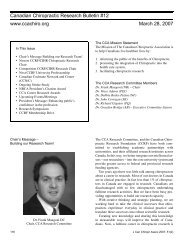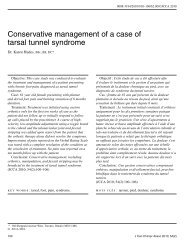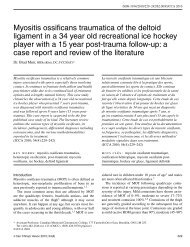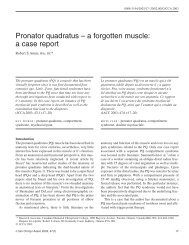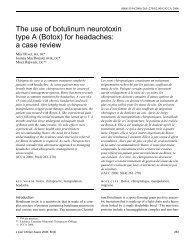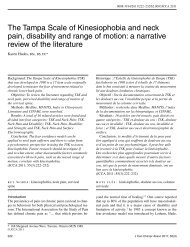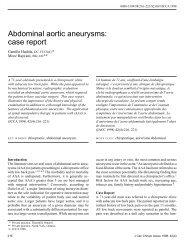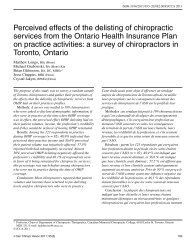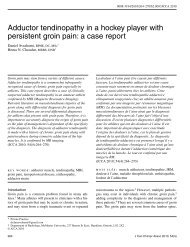An atypical clay shoveler's fracture: a case report - Journal of the ...
An atypical clay shoveler's fracture: a case report - Journal of the ...
An atypical clay shoveler's fracture: a case report - Journal of the ...
You also want an ePaper? Increase the reach of your titles
YUMPU automatically turns print PDFs into web optimized ePapers that Google loves.
Clay shoveler’s <strong>fracture</strong>Figure 1 Lateral view. Initial injury showing avulsion <strong>fracture</strong> through <strong>the</strong> spinousprocess and lamina <strong>of</strong> C7. The <strong>fracture</strong> extending into <strong>the</strong> lamina raised <strong>the</strong> possibility <strong>of</strong>spinal cord involvement. Note <strong>the</strong> minimal inferior displacement.214 J Can Chiropr Assoc 2001; 45(4)
VB Feldman, F Astrifilm radiographs performed <strong>the</strong> same day demonstrated aC7 spinolaminar <strong>fracture</strong> with minimal inferior displacement<strong>of</strong> <strong>the</strong> spinous process fragment (Figure 1). Because<strong>of</strong> <strong>the</strong> interruption in <strong>the</strong> spinolaminar line, computed tomography(CT) was performed to fur<strong>the</strong>r evaluate <strong>the</strong> osseousintegrity <strong>of</strong> <strong>the</strong> region. The results showed no o<strong>the</strong>rosseous involvement. The patient was sent home with ahard cervical collar, and was instructed to rest for fourweeks, and referred back to his family physician.One month later <strong>the</strong> patient presented to <strong>the</strong> H.K. Leeoutpatient clinic at <strong>the</strong> Canadian Memorial ChiropracticCollege for residual neck pain. At <strong>the</strong> time <strong>of</strong> initial presentation,radiographs revealed that <strong>the</strong> spinous fragmentwas still ununited. This type <strong>of</strong> avulsion <strong>fracture</strong> is referredto as a <strong>clay</strong> shoveler’s <strong>fracture</strong>. Physical examination revealedthat his active cervical range <strong>of</strong> motion was reducedby 60% in flexion, left and right lateral flexion, left andright rotation, and reduced by 15% in extension. Left rotationand left lateral flexion produced pain on <strong>the</strong> left side <strong>of</strong><strong>the</strong> cervical spine. Trigger points were present in <strong>the</strong> righttrapezius, levator scapulae, and rhomboids. The leftscalenes were hypertonic. Vertebral joint dysfunction waspresent from C2–4 in left anterior rotation. Neurologicalstatus was normal.The patient received four weeks <strong>of</strong> treatment which includedtrigger-point <strong>the</strong>rapy and light massage 1–2 timesper week. Following this, <strong>the</strong> patient <strong>report</strong>ed a 60% subjectiveincrease in range <strong>of</strong> motion and a decrease in painand stiffness. During this time, <strong>the</strong> patient was also receivingacupuncture <strong>the</strong>rapy at ano<strong>the</strong>r clinic.Follow-up radiographs 2.5 months post-injury revealedosseous callous formation at <strong>the</strong> <strong>fracture</strong> site (Figure 2). Atthis time, spinal manipulative <strong>the</strong>rapy (SMT) was introducedto <strong>the</strong> upper cervical segments. The patient alsocontinued receiving acupuncture <strong>the</strong>rapy. The patient <strong>the</strong>nbegan active rehabilitation that included upper bodystreng<strong>the</strong>ning exercises and neck rehabilitation, using <strong>the</strong>Hanoun Multi Cervical Unit, and was able to return tomore activities <strong>of</strong> daily living. Hapkido was included inhis exercise routine with <strong>the</strong> exception <strong>of</strong> upper bodyballistic movements. The patient was treated 1–2 timesper week for <strong>the</strong> next eight weeks. Following eight weeks<strong>of</strong> treatment, <strong>the</strong> patient <strong>report</strong>ed a complete resolution<strong>of</strong> symptoms.Follow-up radiographs five months post-injury revealedthat <strong>the</strong> spinolaminar <strong>fracture</strong> had healed (Figure 3).Figure 2 Lateral view. Follow-up films 2.5 months postinjury reveal osseous callous formation at <strong>the</strong> <strong>fracture</strong> site.J Can Chiropr Assoc 2001; 45(4) 215
Clay shoveler’s <strong>fracture</strong>DiscussionMechanism <strong>of</strong> injuryThere have been numerous articles with varying opinionson <strong>the</strong> causative mechanism <strong>of</strong> <strong>clay</strong> shoveler’s <strong>fracture</strong>.2,3,4,7,8,9,10,11 However, one well-organized approachis presented by Rowe. 2 He proposes three general mechanisms:direct, indirect and stress-related. The directmechanism is characterized by a blow directly applied to<strong>the</strong> spinous process leading to a <strong>fracture</strong>. This mechanism<strong>of</strong>ten occurs in high contact sports such as basketball, footballand wrestling. 2,4,9The indirect mechanism is <strong>of</strong>ten cited as <strong>the</strong> most commonmechanism and is considered to be a true avulsiontypeinjury. In this mechanism, <strong>the</strong> cervical spineundergoes a ballistic-type motion in flexion, extension orrotation. During abrupt flexion, as in a motor vehicle accident,<strong>the</strong> spinous process may be avulsed due to <strong>the</strong>counterforce <strong>of</strong> <strong>the</strong> supraspinous, interspinous and nuchalligaments, as well as muscle attachments <strong>of</strong> <strong>the</strong> rhomboidsand trapezius, which serve as protective mechanisms. 2,7,9During rapid forced hyperextension, <strong>the</strong> spinous processesare impacted and may <strong>fracture</strong>. Because a force <strong>of</strong> hyperextensionmay produce a myriad <strong>of</strong> <strong>fracture</strong>s one must ruleout more ominous injuries. These include pedicle, pillar,vertebral teardrop and spinolaminar <strong>fracture</strong>s. The ligamentumflavum has also been implicated as a participantin spinolaminar <strong>fracture</strong>s. This type <strong>of</strong> <strong>fracture</strong> has alsobeen associated with o<strong>the</strong>r occupational and sporting activities.These include cricket playing, power-lifting, golfingand a less known occupation <strong>of</strong> metal dipping. 7,14,15,16In addition to flexion and extension, rotation <strong>of</strong> <strong>the</strong> neck ortrunk can play a large role in spinous process avulsions,especially in <strong>the</strong> cervicothoracic region. 2,17Normally, <strong>the</strong> <strong>fracture</strong> occurs along <strong>the</strong> weakest point in<strong>the</strong> spinous process. This has been found to be at <strong>the</strong> narrowestsection, approximately one-half to three-quarterinches from <strong>the</strong> tip. 1The final mechanism may be regarded as a stress-related,fatigue-type <strong>fracture</strong>. In this mechanism, repetitivenormal stress in abnormal bone may lead to a fatigue <strong>fracture</strong>.A <strong>case</strong> <strong>of</strong> a transverse <strong>fracture</strong> through <strong>the</strong> seventhspinous process in <strong>the</strong> cervical spine has been <strong>report</strong>ed in apatient with secondary hyperparathyroidism. 16Figure 3 Lateral view. Follow-up films five months postinjury reveal complete healing <strong>of</strong> <strong>the</strong> <strong>clay</strong> shoveler’s <strong>fracture</strong>.RadiologyThe radiographic appearance demonstrates very classicalfeatures. On <strong>the</strong> lateral view, <strong>the</strong> <strong>fracture</strong> line is more commonlyobliquely oriented, transversing midway between<strong>the</strong> tip <strong>of</strong> <strong>the</strong> spinous and <strong>the</strong> spinolaminar junction (Figure4a). Atypically, <strong>the</strong> <strong>fracture</strong> may extend through <strong>the</strong>spinolaminar line, as in our <strong>case</strong>. The <strong>fracture</strong> margins are216 J Can Chiropr Assoc 2001; 45(4)
VB Feldman, F Astriwhich was first described by Zanca and Lodwell. 4,12,18,20In addition, <strong>the</strong> patient <strong>of</strong>ten presents with a reduced cervicallordosis due to severe muscle spasm. A careful analysis<strong>of</strong> <strong>the</strong> entire cervical and upper thoracic spine should beperformed to rule out <strong>the</strong> presence <strong>of</strong> co-existent <strong>fracture</strong>s.Although <strong>clay</strong> shoveler’s <strong>fracture</strong>s have historically beenconsidered as stable <strong>fracture</strong>s, one must always exclude<strong>the</strong> possibility <strong>of</strong> segmental instability. This can be evaluatedwith flexion/extension studies. The lower cervicalspine may be difficult to visualize due to patient obesity,muscularity, short neck, severe muscle spasm or severepain. 21 With regard to blunt trauma, 39% to 47% <strong>of</strong> patientswith bony injury <strong>of</strong> <strong>the</strong> cervical spine will also havesome form <strong>of</strong> neurological injury. 21If <strong>the</strong>re is a suspicion <strong>of</strong> a more significant bony injurysuch as a facet <strong>fracture</strong>, pedicle <strong>fracture</strong> or unilateraljumped facet, computed tomography should be performed.Ruling out injuries to specific nerve roots or involvement<strong>of</strong> <strong>the</strong> spinal cord such as contusion orimpingement from disc material or osseous fragments, isbest evaluated with magnetic resonance imaging (MRI).Fortunately, most <strong>clay</strong> shoveler’s <strong>fracture</strong>s are not associatedwith injury to <strong>the</strong> spinal cord itself.Figure 4a Lateral View. The <strong>clay</strong> shoveler’s <strong>fracture</strong> istypically located midway between <strong>the</strong> spinous tip andspinolaminar line.serrated with <strong>the</strong> distal spinous fragment ei<strong>the</strong>r displacedposteriorly or posterior-inferior. Lateral displacement canbe best visualized on <strong>the</strong> AP view. On <strong>the</strong> AP view,malalignment and displacement <strong>of</strong> <strong>the</strong> distal spinous fragmentlead to simultaneous visualization <strong>of</strong> <strong>the</strong> <strong>fracture</strong>dbase and <strong>the</strong> caudally displaced spinous tip. This featurehas been termed <strong>the</strong> “double spinous” sign (Figure 4b)Differential diagnosisTwo conditions that are <strong>of</strong>ten confused with <strong>clay</strong>shoveler’s <strong>fracture</strong> are nuchal bone formation and anununited secondary ossification center <strong>of</strong> <strong>the</strong> spinous tip.O<strong>the</strong>r less common entities include omovertebral bones,congenital bent spinous, pathological <strong>fracture</strong> and spinabifida occulta. 2Ununited secondary ossification centres may appear tosimulate an avulsion <strong>of</strong> <strong>the</strong> spinous tip. The distinction ismade by close observation <strong>of</strong> three key features. First, <strong>the</strong>opposing margins are smooth and sclerotic. Second, <strong>the</strong>distal ununited segment is in close proximity to <strong>the</strong> remainder<strong>of</strong> <strong>the</strong> spinous without caudal displacement.Third, <strong>the</strong> ununited segment may possess a concave margin,which is continuous with <strong>the</strong> convex surface <strong>of</strong> <strong>the</strong>opposing spinous (Figure 5). 2Nuchal bones occur with ossification <strong>of</strong> a portion <strong>of</strong> <strong>the</strong>nuchal ligament. They are easily differentiated by <strong>the</strong>irslightly elongated shape, and <strong>the</strong>ir more posterior position.In addition, <strong>the</strong> spinous process remains intact (Figure 6).Nuchal ligament ossification is <strong>of</strong>ten observed after <strong>the</strong>age <strong>of</strong> 40 and is <strong>of</strong>ten clinically asymptomatic.J Can Chiropr Assoc 2001; 45(4) 217
Clay shoveler’s <strong>fracture</strong>Figure 4b AP View. Inferior displacement <strong>of</strong> <strong>the</strong> spinous tip leads to a double spinous appearance known as<strong>the</strong> “double spinous” sign.218 J Can Chiropr Assoc 2001; 45(4)
VB Feldman, F AstriTreatmentClay shoveler’s <strong>fracture</strong>s tend to be stable as long as only<strong>the</strong> spinous process is involved. However, if <strong>the</strong> <strong>fracture</strong>extends into <strong>the</strong> spinolaminar region, pedicle or pillar, onemust rule out spinal instability, nerve root and spinal cordinvolvement.The literature is unclear as to whe<strong>the</strong>r <strong>the</strong> avulsedspinous fragment should be excised. 4 However, treatmentshould begin with a conservative approach. This typicallymay involve <strong>the</strong> use <strong>of</strong> a s<strong>of</strong>t cervical collar, especially in<strong>the</strong> acute stage. The collar may be worn intermittently toprevent muscle atrophy over a period <strong>of</strong> 4–6 weeks. 2Modalities such as ultrasound or microcurrent may be appliedto damaged s<strong>of</strong>t tissues. If severe pain persists evenafter conservative management, <strong>the</strong>n surgical excision <strong>of</strong><strong>the</strong> avulsed fragment may be warranted.PrognosisNon-union <strong>of</strong> <strong>the</strong> avulsed fragment is common due to <strong>the</strong>muscular pull in this region. However, with minimal displacement<strong>of</strong> <strong>the</strong> avulsed fragment, reattachment may occur.Typical <strong>clay</strong> shoveler’s <strong>fracture</strong>s tend to heal withoutresidual sequelae in terms <strong>of</strong> neck function or pain.ConclusionThis paper described an <strong>atypical</strong> <strong>clay</strong> shoveler’s <strong>fracture</strong>with disruption <strong>of</strong> <strong>the</strong> spinolaminar line. In addition this<strong>case</strong> presented serial radiographs demonstrating completebony healing <strong>of</strong> a spinolaminar <strong>fracture</strong>. Most <strong>clay</strong>shoveler’s <strong>fracture</strong>s are stable, however, with involvement<strong>of</strong> <strong>the</strong> lamina additional osseous involvement or more seriousspinal cord involvement may be ruled out with computedtomography and magnetic resonance imagingrespectively.References1 Hall M. Clay-Shoveller’s <strong>fracture</strong>. J Bone Joint Surg 1940;12(1):63–75.2 Rowe LJ. Clay Shoveler’s <strong>fracture</strong>. ACA J Chiropractic1987; 21(1):83–86.3 Harris JH. The Radiology <strong>of</strong> Acute Cervical SpineTrauma, Second Edition. Baltimore: Williams andWilkins, 1987; 71,73,108,123,124,125.4 Nuber GW, Schafer MF. Clay shovelers’ injuries: A <strong>report</strong><strong>of</strong> two injuries sustained from football. Amer J Sports Med1987; 15(2):182–183.5 Weston WJ. Clay Shoveler’s disease in adolescentsFigure 5 Lateral view. Nonunion <strong>of</strong> <strong>the</strong> secondary growthcentre <strong>of</strong> <strong>the</strong> C7 spinous process. Note <strong>the</strong> smooth,undisplaced sclerotic margins between <strong>the</strong> osseoussegments.(Schmitt’s Disease): A <strong>report</strong> <strong>of</strong> two <strong>case</strong>s. British J Radiol1957; 30:378–380.6 Baker BK, Sundaram M, Awwad EE. Case <strong>report</strong> 688.Skeletal Radiol 1991; 20:463–464.7 Meyer PG, Hartman JT, Leo JS. Sentinel spinous process<strong>fracture</strong>s. Surg Neurol 1982; 18(3):174–178.8 Murphy M, Batnitz S, Bramble J. Diagnostic Imaging <strong>of</strong>Spinal Trauma. Radiologic Clinics <strong>of</strong> North America1989; 27:861–863.9 Yochum TR, Rowe LJ. Essentials <strong>of</strong> Skeletal Radiology,Second Edition. Baltimore: Williams and Wilkins, 1996;680,681.10 Epstein BS. The Spine: A Radiological Text, ThirdEdition. Philadelphia: Lea and Febiger, 1969; 477,478,479.11 Hakkal HG. Clay Shoveler’s <strong>fracture</strong>. Amer FamPhysician 1973; 8(1):104–106.12 Zanca P, Lodmell EA. Fracture <strong>of</strong> <strong>the</strong> spinous processes:A new sign for <strong>the</strong> recognition <strong>of</strong> <strong>fracture</strong>s <strong>of</strong> <strong>the</strong> cervicalJ Can Chiropr Assoc 2001; 45(4) 219
Clay shoveler’s <strong>fracture</strong>Figure 6 Lateral View. Nuchal Ligament Ossification. The elongated shape <strong>of</strong> <strong>the</strong>nuchal ossification and intact spinous tip helps differentiate this from a <strong>clay</strong>shoveler’s <strong>fracture</strong>.and upper dorsal spinous processes. Radiology 1951;56:427–429.13 Delt<strong>of</strong>f M, Kogon P. The Portable Skeletal X-Ray Library.Mosby, 1998; 250.14 Zimmer EA, Wilk SP. Borderlands <strong>of</strong> <strong>the</strong> Normal andEarly Pathologic in Skeletal Roentgenology, EleventhEdition. Grune and Stratton, 1968; 327,328.15 Herrick RT. Clay-shoveler’s <strong>fracture</strong> in power-lifting: A<strong>case</strong> <strong>report</strong>. Amer J Sports Med 1981; 9(1):29–30.16 Marumo F, Nomura T, Nishikawa H. Transverse <strong>fracture</strong>s<strong>of</strong> <strong>the</strong> spinous process <strong>of</strong> <strong>the</strong> 7th cervical vertebra in RDTpatients: an Al related disease? International J ArtificialOrgans 1987; 10(2):93–96.17 Rogers LF. Radiology <strong>of</strong> Skeletal Trauma. ChurchillLivingstone, 1982; 300,301.18 Resnick D. Diagnosis <strong>of</strong> Bone and Joint Disorders, ThirdEdition. WB Saunders Co, 1995; 2861,2863.19 Cimmino CV, Scott DW. Laminar avulsion in a cervicalvertebra. Am J Roentgenol 1977; 129:57–60.20 Cancelmo JJ. Clay Shoveler’s <strong>fracture</strong>: A helpfuldiagnostic sign. Am J Roentgenol Radium Ther Nucl Med1972; 115:540–543.21 Tehranzadeh J, Bonk RT, <strong>An</strong>sari A, Mesgarzadeh M.Efficacy <strong>of</strong> limited CT for nonvisualized lower cervicalspine in patients with blunt trauma. Skeletal Radiology1994; 23:349–352.220 J Can Chiropr Assoc 2001; 45(4)



